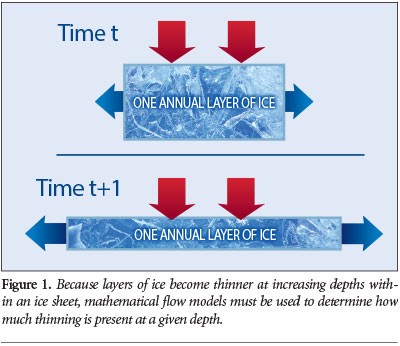No products in the cart.
Return To ShopIce Cores: Do they Disprove Biblical Timelines?
Greenland is covered by ice sheets that span more than 700,000 square miles with an average depth of 5,300 feet. The deepest known section is estimated at around 11,300 feet.[i] Since the 1960s, scientists have drilled and extracted cylindrical cores from the ice sheets (called ice cores) from depths of over 10,000 feet.
According to some scientists, the age of these ice sheets can be estimated by counting the number of what they call “annual layers” in the cores. In the GISP2 Ice Core, which was taken from the Greenland ice sheet, scientists counted 110,000 layers. They insist 110,000 years must have made them. Is the dating process really that straightforward? Not at all. For example, they forget that one storm can deposit several layers. As we have seen with the fossil record, geologic rock layers, and other remnants from the past, the worldview and assumptions of the scientists analyzing the data play a big role in their conclusions. Let’s take a closer look.
In the upper latitudes, snow accumulates on top of the ice sheet and eventually turns into ice. The weight of the top layer exerts pressure on the layers below and causes them to spread out and become thinner (Figure 1).

Figure 1: The weight of the top layers of ice exerts pressure on the layers below and causes them to spread and thin.[ii]
Consequently, the layers near the bottom of the ice sheet are much thinner than the layers near the top. Some of the bottom layers are one millimeter thin.[iii] There are too many layers to count and they are too thin to identify consistently. They therefore use flow models to estimate time for ice thicknesses. Guess what variable their models include: deep time. No wonder they think the ice is so old—they assumed it in the first place. Scientists have to use a variety of techniques (i.e. lasers, isotope readings, etc.) to identify the layers. Do they represent annual layers or something else? Secular scientists believe the “present is the key to the past” (uniformitarianism) and assume millions of years. Scientists who believe the Bible’s timeline need to explain these many thin layers. The Flood explains it well, although indirectly. Here’s how.
Warm ocean temperatures and volcanic activity following the Global Flood caused the Ice Age (see Ice Age). When describing the Flood, the Bible tells us: “…all the fountains of the great deep were broken up, and the windows of heaven were opened” (Genesis 7:11). Many creation scientists believe this passage refers to tremendous earthquakes, tsunamis and volcanic eruptions and flooding occurring on a global scale. Ice sheets formed rapidly during the Ice Age, which lasted around 700 years.[iv] Therefore, many of the compressed rings near the bottom of the ice sheets may not actually be annual rings, but rather formed during the frequent and powerful snow storms that occurred after the flood. Michael Oard’s post flood Ice Age theory provides the only adequate cause for the Ice Age. This task has baffled secular scientists for half a century. Bottom line, the layers do not represent years after all.
Want more evidence? Fortunately, it exists! During World War II (July 1942), two B-17 bombers and six P-38 fighters encountered a severe snowstorm and were forced to make an emergency landing in southeast Greenland. All pilots were rescued, but the planes were abandoned, left to be covered by ice over the ensuing years.[v] In August 1992, a privately-funded team went back to recover one of the planes—thinking it would be easy to do so given uniformitarian assumptions of the slow, gradual accumulation of ice layers. They were surprised to find the planes covered with more than 260 feet of ice. It had accumulated in just fifty years.[vi] The team recovered one of the P-38s and named it “Glacier Girl.”
The fact that over 260 feet of ice had accumulated in just fifty years demonstrated that ice sheets can accumulate very quickly. At that rate of accumulation, it is reasonable to expect that Greenland’s three-kilometer-thick ice sheet can form in much less than the ~4,400 years since the Flood.[vii]
[i] Michael J. Oard, “Are the Greenland and the Antarctic Ice Sheets old?” Creation.com: https://creation.com/ice-sheet-age (November 5, 2018).
[ii] Jake Hebert, “Ice Cores, Seafloor Sediments, and the Age of the Earth, Part 1.” Institute for Creation Research: www.icr.org/article/8130/
[iii] Jake Hebert, “Ice Cores, Seafloor Sediments, and the Age of the Earth, Part 2.” Institute for Creation Research: www.icr.org/article/8181/
[iv] Oard, 2018.
[v] Jake Hebert, “WWII Plane Found Frozen in Greenland Ice,” (September 11, 2018). Institute for Creation Research.
[vi] Glacier Girl. Lewis Air Legends. Posted on lewisairlegends.com.
Jensen, “Glacier Girl: The Back Story.” (1993). Originally published as Iced Lightning. Smithsonian Air & Space magazine. Posted on airspacemag.com (July 2007) (August 28, 2018).
[vii] Hebert, Ibid.






![[eBook] The Nephilim: Was There a Giant Problem in The Americas](https://genesisapologetics.com/wp-content/uploads/2024/11/Nephilim-Product-Image-100x100.png)
